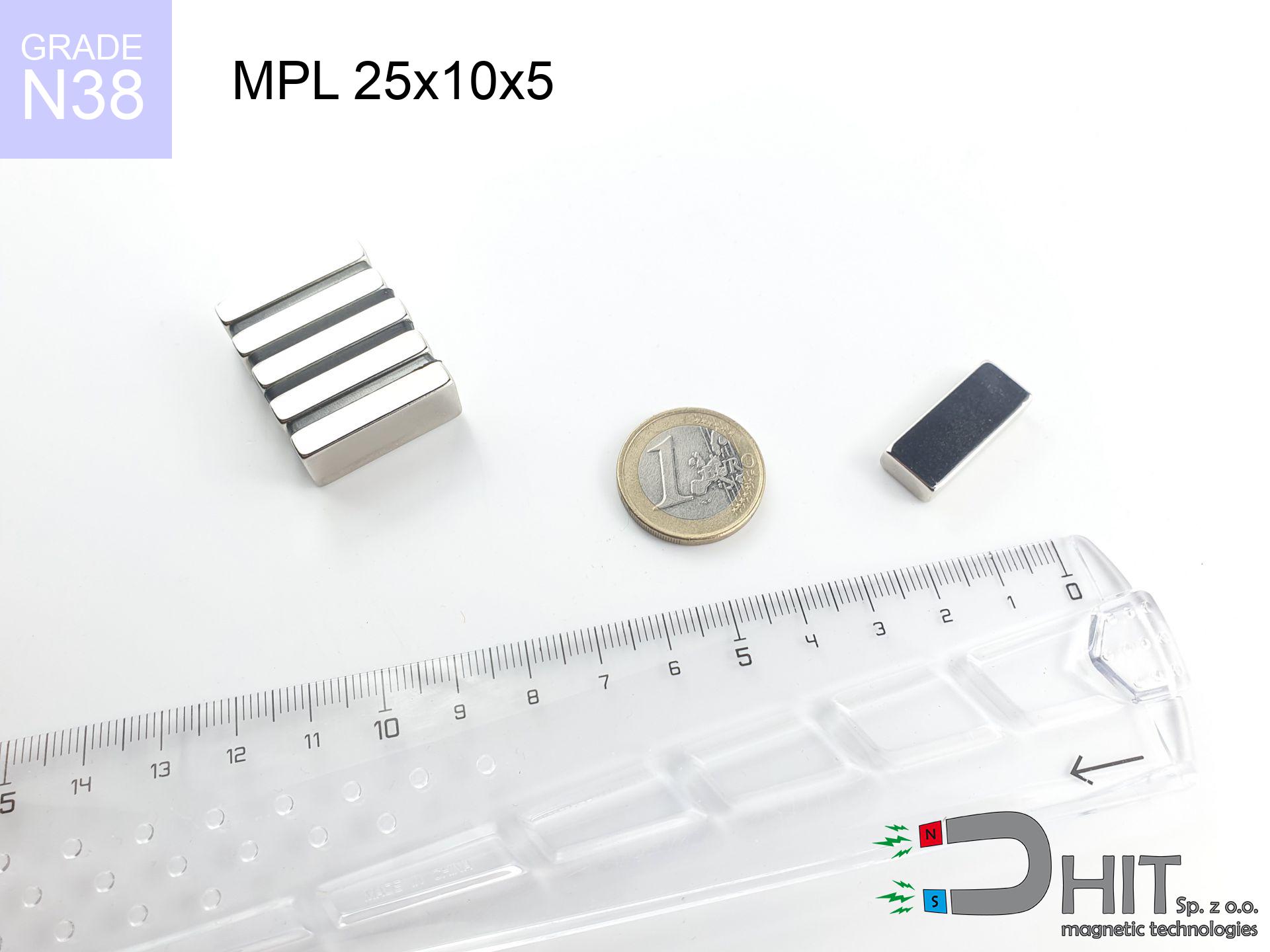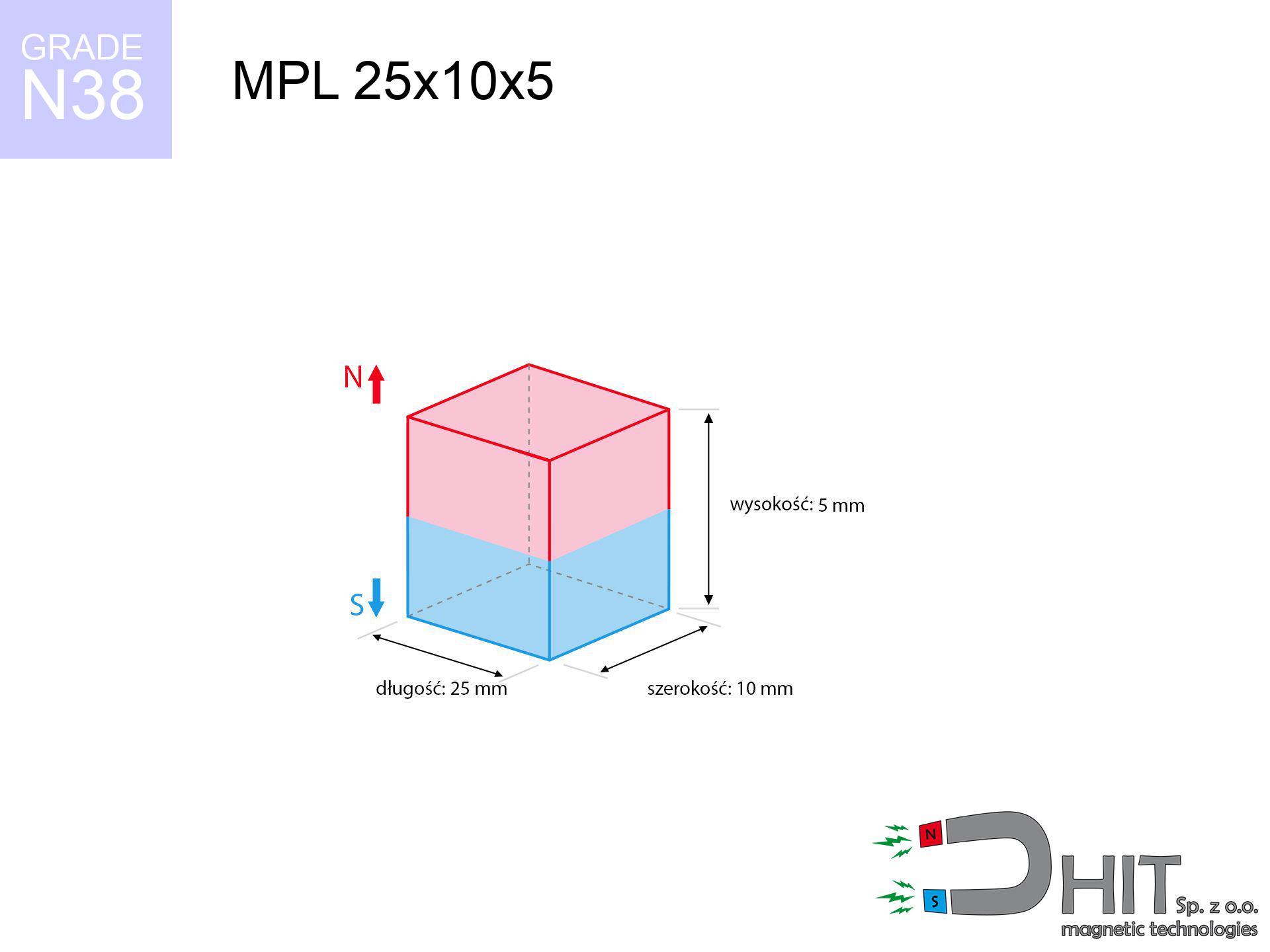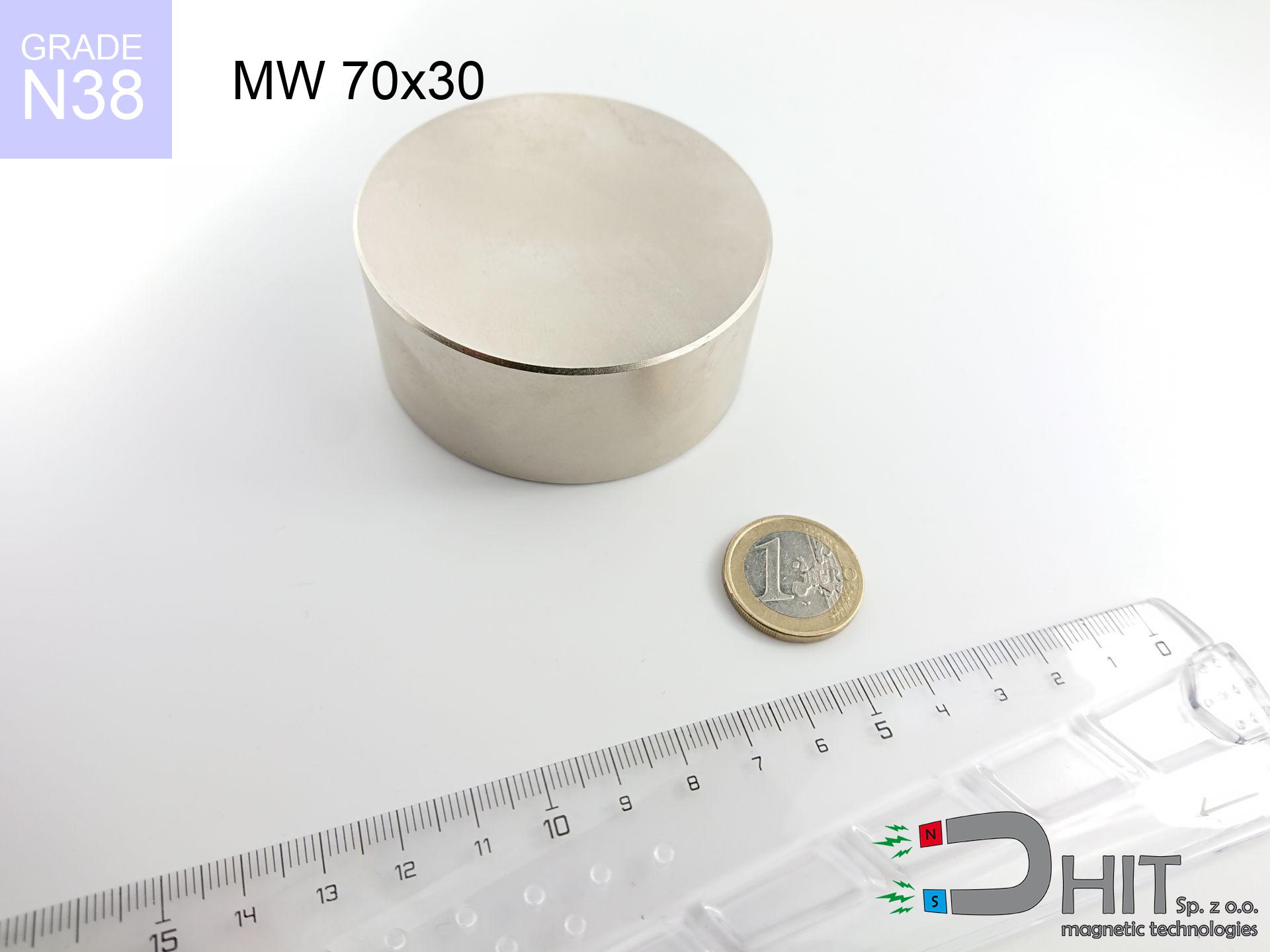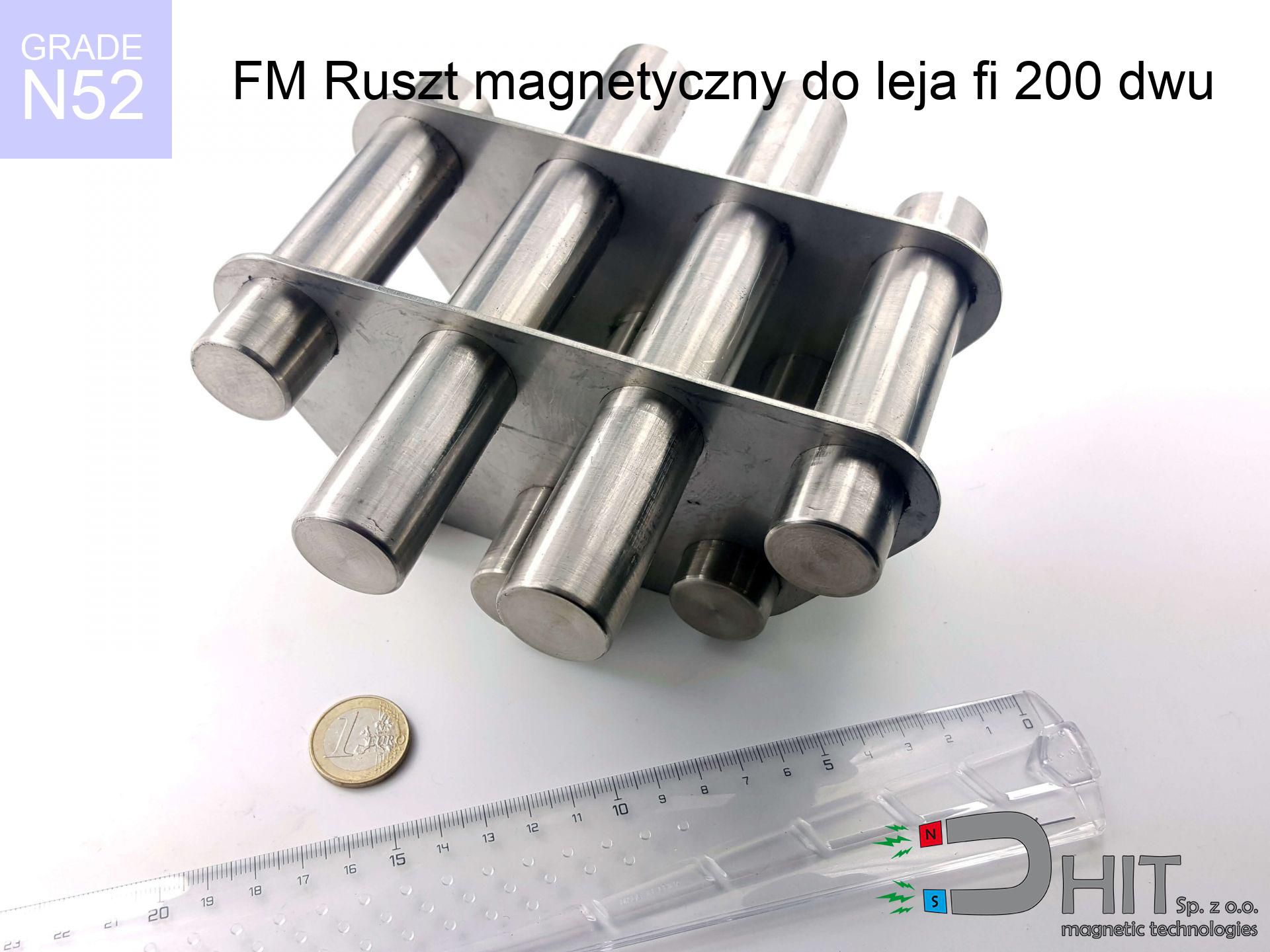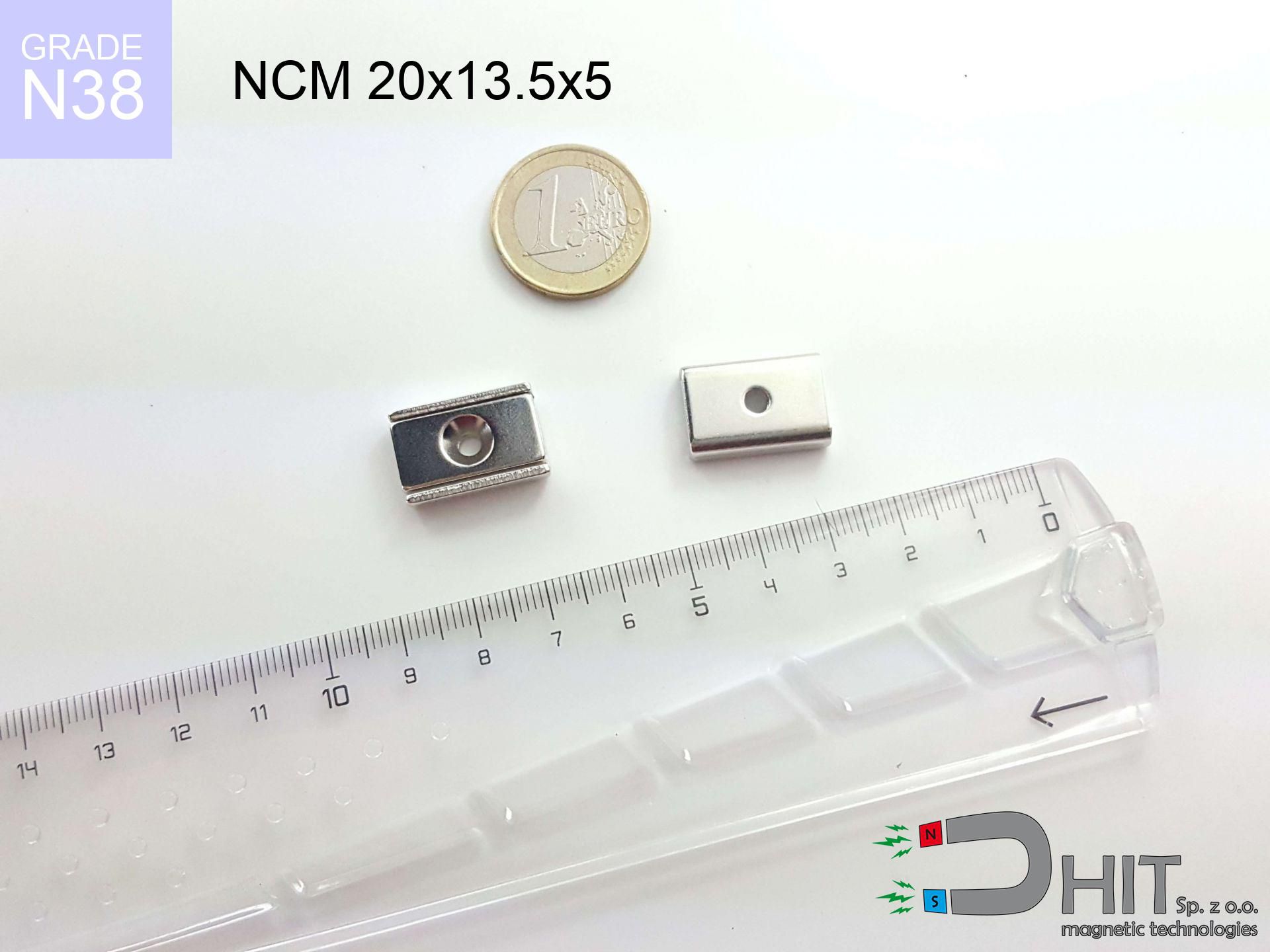MPL 25x10x5 / N38 - neodymium magnet
lamellar magnet
catalog number 020135
GTIN: 5906301811411
length
25
mm [±0,1 mm]
width
10
mm [±0,1 mm]
height
5
mm [±0,1 mm]
magnetizing direction
↑ axial
capacity ~
6.24 kg / 61.19 N
magnetic induction ~
337.05 mT / 3,371 Gs
max. temperature
≤ 80
°C
catalog number 020135
GTIN: 5906301811411
length
25 mm [±0,1 mm]
width
10 mm [±0,1 mm]
height
5 mm [±0,1 mm]
magnetizing direction
↑ axial
capacity ~
6.24 kg / 61.19 N
magnetic induction ~
337.05 mT / 3,371 Gs
max. temperature
≤ 80 °C
4.30 ZŁ gross price (including VAT) / pcs +
3.50 ZŁ net price + 23% VAT / pcs
bulk discounts:
need more quantity?Don't know what to choose?
Give us a call tel: +48 888 99 98 98 or contact us through contact form on the contact page. You can check the power as well as the appearance of neodymium magnet in our power calculator magnetic calculator
Orders placed by 2:00 PM will be shipped on the same business day.
Specification: lamellar magnet 25x10x5 / N38 ↑ axial
Magnetic properties of the material N38
Physical properties of sintered neodymium magnets Nd2Fe14B
Contact Surface: Thanks to their flat shape, disc magnets guarantee a significant contact surface with adjoining parts, which can be beneficial in applications needing a stronger magnetic connection.
Applications in Technology: These magnets are often employed in various devices, such as sensors, stepper motors, or speakers, where a flat shape is essential for their operation.
Mounting: This form's flat shape makes mounting, particularly when there's a need to adhere the magnet to another surface.
Design Flexibility: The disc shape of the magnets provides designers with significant flexibility in arranging them in devices, which can sometimes be more difficult with magnets of other shapes.
Stability: In some applications, the flat base of a disc magnet may provide better stability, minimizing the risk of shifting or rotating. However, it's important to remember that the optimal shape of a magnet depends on the particular use and requirements. In some cases, other shapes, like cylindrical or spherical, may be more suitable.
Find suggested articles
Advantages and disadvantages of neodymium magnets NdFeB.
In addition to immense power, neodymium magnets have the following advantages:
- They do not lose their power (of the magnet). After about 10 years, their strength decreases by only ~1% (theoretically),
- They are highly resistant to demagnetization by external magnetic sources,
- By applying a shiny coating of nickel, gold, or silver, the element gains an aesthetic appearance,
- They have exceptionally high magnetic induction on the surface of the magnet,
- Magnetic neodymium magnets are characterized by hugely high magnetic induction on the surface of the magnet and can operate (depending on the shape) even at temperatures of 230°C or higher...
- The ability for precise shaping or customization to specific needs – neodymium magnets can be produced in various forms and dimensions, which expands the range of their possible uses.
- Key role in modern technologies – are used in HDD drives, electric motors, medical devices and other highly developed apparatuses.
Disadvantages of neodymium magnets:
- They can break when subjected to a powerful impact. If the magnets are exposed to impacts, we recommend using magnets in a metal holder. The steel housing in the form of a holder protects the magnet from impacts and at the same time increases its overall strength,
- High temperatures can reduce the power of neodymium magnets. Typically, after heating above 80°C, most of them experience a permanent loss in strength (although it is dependent on the shape and size). To prevent this, we offer special magnets marked with the symbol [AH], which are highly resistant to high temperatures. They can operate even at temperatures up to 230°C, making them an ideal solution for applications requiring high-temperature operation,
- They rust in a humid environment - during outdoor use, we recommend using waterproof magnets, such as those made of rubber or plastic,
- The use of a cover - a magnetic holder is recommended due to the limited production capabilities of creating threads or complex shapes in the magnet
- Health risk associated with microscopic parts of magnets can be dangerous, in case of ingestion, which is crucial in the context of children's health. Additionally, small elements of these devices can be problematic in medical diagnosis after entering the body.
Caution with Neodymium Magnets
Neodymium magnets are known for being fragile, which can cause them to become damaged.
Neodymium magnetic are delicate as well as will shatter if allowed to collide with each other, even from a distance of a few centimeters. They are coated with a shiny nickel plating similar to steel, but they are not as hard. At the moment of collision between the magnets, tiny sharp metal fragments can be propelled in various directions at high speed. Eye protection is recommended.
Keep neodymium magnets away from children.
Neodymium magnets are not toys. You cannot allow them to become toys for children. In such a situation, surgery is necessary to remove them. In the worst case scenario, it can result in death.
Neodymium magnets are over 10 times stronger than ferrite magnets (the ones in speakers), and their strength can surprise you.
To handle magnets properly, it is best to familiarize yourself with our information beforehand. This will help you avoid significant harm to your body and the magnets themselves.
Do not bring neodymium magnets close to GPS and smartphones.
Magnetic fields generated by neodymium magnets interfere with compasses and magnetometers used in navigation, as well as internal compasses of smartphones and GPS devices.
It is crucial not to allow the magnets to pinch together uncontrollably or place your fingers in their path as they attract to each other.
In the case of holding a finger in the path of a neodymium magnet, in that situation, a cut or even a fracture may occur.
Under no circumstances should neodymium magnets be placed near a computer HDD, TV, and wallet.
Neodymium magnets generate intense magnetic fields that can damage magnetic media such as floppy disks, video tapes, HDDs, credit cards, magnetic ID cards, cassette tapes, or other devices. They can also damage videos, televisions, CRT computer monitors. Do not forget to keep neodymium magnets away from these electronic devices.
Neodymium magnets can demagnetize at high temperatures.
While Neodymium magnets can demagnetize at high temperatures, it's important to note that the extent of this effect can vary based on factors such as the magnet's material, shape, and intended application.
The magnet coating contains nickel, so be cautious if you have a nickel allergy.
Studies clearly indicate a small percentage of people who suffer from metal allergies such as nickel. An allergic reaction often manifests as skin redness and rash. If you have a nickel allergy, you can try wearing gloves or simply avoid direct contact with nickel-plated neodymium magnets.
Dust and powder from neodymium magnets are highly flammable.
Do not attempt to drill into neodymium magnets. Mechanical processing is also not recommended. If the magnet is crushed into fine powder or dust, it becomes highly flammable.
People with pacemakers are advised to avoid neodymium magnets.
In the case of neodymium magnets, there is a strong magnetic field. As a result, it interferes with the operation of a heart pacemaker. Even if the magnetic field does not affect the device, it can damage its components or deactivate the entire device.
So you are aware of why neodymium magnets are so dangerous, read the article titled How very dangerous are very strong neodymium magnets?.

